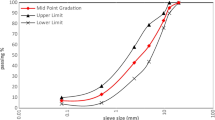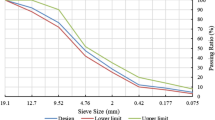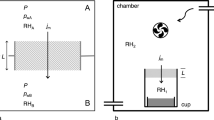Abstract
Standard laboratory ageing methods of bitumen only take into account the effect of thermo-oxidation during the service life of a pavement but the effect of high energy cosmic radiation on site is not simulated in these procedures. The aim of the present work is to compare the laboratory simulated short term bitumen ageing (rolling thin film oven test) with ageing produced by short exposures of bitumen samples to Ultra Violet and gamma radiation. The influence of ageing agents on the thermal properties and rheological performance of the pristine and modified bitumen binders has been evaluated in this study. The thermal behavior of various aged bitumens is characterized by both isothermal as well as non-isothermal thermogravimetric analysis. The thermoanalytic investigations on bituminous samples are carried out to evaluate the thermal stabilities and activation energies of the binders and the life time prediction of the materials is made with the help of the kinetic information. It is found that modified bituminous binders are more resistant to heat and radiation. Different rheological tests are conducted by dynamic shear rheometer to examine the effect of ageing in terms of bitumen oxidation and polymer phase degradation which has a major consequence on high temperature rutting or low temperature cracking. Type of modifier is found to be of decisive importance. Creep and recovery tests show that the structure-time dependency of pristine aged bitumen is influenced much by stress and temperature than in the case of modified aged bitumens. The study has revealed that the elastomeric modifier protects the bituminous binder more than plastic modifier or nano filler. Finally, a fair correlation has been made between standard RTFO ageing and radiation aging.











Similar content being viewed by others
References
Sengoz B, Topal A, Isikyakar G (2009) Morphology and image analysis of polymer modified bitumens. Constr Build Mater 23:1986–1992
Durrieu F, Farcas F, Mouillet V (2007) The influence of UV ageing of a styrene/butadiene/styrene modified bitumen: comparison between laboratory and on site ageing. Fuel 86:1446–1451
Burnay SG (1987) Comparative evaluation of α and γ- radiation effects in a bitumenisate. Nucl Chem Waste Manag 7:107–127
UNSCEAR (2000) Sources and effect of ionizing radiation. United Nation Scientific Committee of the Effect Atomic Radiation Report on The General Assembly, United Nation, New York
Lu XH, Isacsson U (1998) Chemical and rheological evaluation of ageing properties of SBS polymer modified bitumens. Fuel 77:961–972
Navarro FJ, Partal P, García-Morales M, Martín-Alfonso MJ, Martínez-Boza F, Gallegos C, Bordado JCM, Diogo AC (2009) Bitumen modification with reactive and non-reactive (virgin and recycled) polymers: a comparative analysis. J Ind Eng Chem 15:458–464
Jahromi SG, Khodaii A (2009) Effects of nanoclay on rheological properties of bitumen binder. Constr Build Mater 23:2894–2904
Petersen JC, Branthaver JF, Robertson RE, Harnsberger PM, Duvall JJ, Ensley EK (1993) Effects of physicochemical factors on asphalt oxidation kinetics. Transp Res Record 1391:1–10
Traxler RN (1961) Relation between asphalt composition and hardening by volatilization and oxidation. Proc Assoc Asphalt Paving Technol 30:359–377
He W, Jiang YY, Luyt AS, Ocaya RO, Ge TJ (2011) Synthesis and degradation kinetics of a novel polyester containing bithiazole rings. Thermochim Acta 525:9–15
Naskar M, Chaki TK, Reddy KS (2010) Effect of waste plastic as modifier on thermal stability and degradation kinetics of bitumen/waste plastics blend. Thermochim Acta 509:128–134
Benbouzid M, Hafsi S (2008) Thermal and kinetic analyses of pure and oxidized bitumens. Fuel 87:1585–1590
Gawel I, Bociarska D, Biskupski P (2005) Effect of asphaltenes on hydroprocessing of heavy oils and residua. Appl Catal A 295:89–94
Mouillet V, Farcas F, Besson S (2008) Ageing by UV radiation of an elastomer modified bitumen. Fuel 87:2408–2419
Mouillet V, Lamontagne J, Durrieu F, Planche JP, Lapalu L (2008) Infrared microscopy investigation of oxidation and phase evolution in bitumen modified with polymers. Fuel 87:1270–1280
Naskar M, Chaki TK, Reddy KS (2011) Effect of recycled EVA as modifier on the various properties of bituminous binder for road application. Adv Mater Res 214:339–343
Garcia-Morales M, Partal P, Navarro FJ, Martinez-Boza F, Gallegos C (2004) Linear viscoelasticity of recycled EVA-modified bitumens. Energy Fuels 18(357):364
Naskar M, Chaki TK, Reddy KS (2012) A novel approach to recycle the waste plastics by bitumen modification for paving application. Adv Mater Res 356–360:1763–1768
Pelet R, Behar F, Monin JC (1986) Resins and asphaltenes in the generation and migration of petroleum. Org Geochem 10:481–498
Cortizo MS, Larsen DO, Bianchetto H, Alessandrini JL (2004) Effect of the thermal degradation of SBS copolymers during the ageing of modified asphalts. Polym Degrad Stab 86:275–282
Airey GD (2002) Rheological evaluation of ethylene vinyl acetate polymer modified bitumens. Constr Build Mater 16:473–487
Fambri L, Pegoretti A, Gavazza C, Penati A (2001) Thermooxidative stability of different polyurethanes evaluated by isothermal and dynamic methods. J Appl Polym Sci 81:1216–1225
Wang H, Tao X, Newton E (2004) Thermal degradation kinetics and lifetime prediction of a luminescent conducting polymer. Polym Int 53:20–26
Budrugeac P (2000) On the use of oxidative stability measurements for short-term thermal endurance characterization of polymeric materials. Polym Degrad Stab 68:289–293
Li XG, Huang MR (1999) Thermal decomposition kinetics of thermotropic poly(oxybenzoate-co-oxynaphthoate) Vectra copolyester. Polym Degrad Stab 64:81–90
Morea F, Agnusdei JO, Zerbino R (2010) Comparison of methods for measuring zero shear viscosity in asphalts. Mater Struct 43:499–507
Morea F, Agnusdei JO, Zerbino R (2011) The use of asphalt low shear viscosity to predict permanent deformation performance of asphalt concrete. Mater Struct 44:1241–1248
Zoorob SE, Castro-Gomes JP, Oliveira LAP, O’Connell J (2012) Investigating the multiple stress creep recovery bitumen characterisation test. Constr Build Mater 30:734–745
Edwards Y, Tasdemir Y, Isacsson U (2006) Influence of commercial waxes and polyphosphoric acid on bitumen and asphalt concrete performance at low and medium temperatures. Mater Struct 39:725–737
Chen JS, Huang CC, Chu PY, Lin KY (2007) Engineering characterization of recycled asphalt concrete and aged bitumen mixed recycling agent. J Mater Sci 42:9867–9876
Isacsson U, Lu X (1999) Characterization of bitumens modified with SEBS, EVA and EBA polymers. J Mater Sci 34:3737–3745
Wasage TLJ, Cantu M, Stastna J, Polacco G, Zanzotto L (2007) Role of viscosity in dynamic creep tests in conventional, oxidized, and polymer-modified asphalts. Transp Res Rec 1998:56–64
Acknowledgments
The authors would like to gratefully acknowledge Prof. A. Saha, UGC-DAE Consortium for Scientific Research, Kolkata Centre, for his help in carrying out gamma irradiation. M. Naskar thankfully acknowledges the Council of Scientific and Industrial Research, New Delhi, India for fellowship.
Author information
Authors and Affiliations
Corresponding author
Rights and permissions
About this article
Cite this article
Naskar, M., Reddy, K.S., Chaki, T.K. et al. Effect of ageing on different modified bituminous binders: comparison between RTFOT and radiation ageing. Mater Struct 46, 1227–1241 (2013). https://doi.org/10.1617/s11527-012-9966-3
Received:
Accepted:
Published:
Issue Date:
DOI: https://doi.org/10.1617/s11527-012-9966-3




